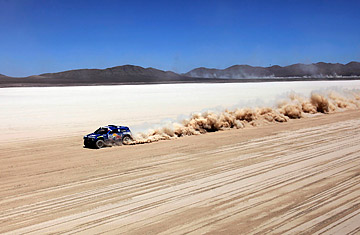
Giniel De Villiers of South Africa drives his Volkswagen Touareg during the fourth stage of the 2011 South American Dakar Rally.
The prevailing image of Chile's Atacama Desert is desolate — the mountainous moonscape where 33 miners were trapped underground for 70 days last year until their triumphant rescue. But the driest place on earth has another side. A miraculous sea of flowers blooms there every few years when rain does fall. And this month, for the third straight year, the 16-day Dakar Rally, arguably the world's most prestigious, grueling and dangerous marathon off-road race, or "raid," is winding much of its way through the Atacama, turning it into a deafening, carnivalesque roar of hundreds of cars, trucks, motorcycles and all-terrain vehicles. "Seeing [this] up close is the maximum emotion," says Gines Pulgar, who drove 3,000 km (1,864 mls) from southern Chile this week to follow the endurance epic, which ends on Sunday in Buenos Aires, Argentina.
What South Americans like Pulgar thought would be just a temporary spectacle could become a permanent, and lucrative, fixture on their continent. Until a couple years ago the Dakar, first held in 1978, had been a European-African rally raid, run from Paris to Dakar, Senegal (with vehicles ferried across the Strait of Gibraltar), and back again. But terrorism concerns in North Africa, which forced cancellation of the 2008 running, prompted the race's overseer, the French Amaury Sports Organization, to find a new locale, at least provisionally.
Argentina and northern Chile offered the right, challenging terrain — free of security threats — and the rally picked up again in the New World in 2009. This year it's a 9,618 km (5,976 mls), 13-stage odyssey that started on Jan. 1 in Buenos Aires. It headed through the sierras that separate the two countries, looping through the Atacama to Chile's Pacific coast, and finishes back in B.A. on Jan. 16. The drivers and riders locate designated points with little more than maps and compasses.
Some of the rally's most exciting moments have come in the Chilean desert, near the dusty mining town of Copiapó — the only city to play host to legs of the rally all three years it's been held in South America — where the punishing sun and topography have put numerous entrants out of the running. This year's 9th and 10th stages were a tortuous route of mountains and dunes from Antofogasta, Chile, through Copiapó and back into Argentina, forcing out veteran drivers like Team Hummer's Eliseo Salazar, 57, of Chile, who blew his transmission in the soft sand. "It was brutal," he says. But the region "is the heart of the Dakar," says Nicolás Noman Garrido, governor of the Atacama province. "I won't even speculate about the possibility of [the rally] not returning next year."
Indeed, rally officials confirmed on Friday that next year's Dakar will be held again in Argentina and Chile. "South America has projected the Dakar in its popular historic dimension," says Dakar Deputy Director Frédéric Lequien. "Argentina and Chile are most welcoming territory for the Dakar... and for them [the race] is a global showcase."
So much so that Peru, Bolivia and Brazil have expressed interest in hosting a stretch of the Dakar themselves. That's largely because the showcase brings cases of money. There really is no prize to be won in the Dakar; the more than 400 teams that participate do it not for cash but cachet. But many of them, with power sponsors like BMW, Mitsubishi, Volkswagen and Hummer, and famous racers like NASCAR and Indy 500 star Robby Gordon, spend millions of dollars for the souped-up vehicles, crews, equipment, transport and lodging a serious run requires. "This is a rich man's sport," says Roger Willis, one of a dozen members of Gordon's Hummer crew. (Mechanical failure forced Gordon to drop out last week near the Argentina-Chile border.) Argentina paid $5 million to host the Dakar this year — and expects to see a return of $170 million. The region around Copiapó expects 15,000 visitors spending almost $10 million.
In stark contrast to the opulence of the big-name camps that pitched tents outside Copiapó — and whose trucks open like garage doors revealing replacement tires and myriad drawers full of neatly labeled tools — is the thrift of off-road enthusiasts like architect Juan Carlos Unzue. Like most South America racing fans who never thought they'd see a rally of Dakar's caliber held there, Unzue, 48, sold a plot of land near his home in Villa Constitución, Argentina, to finance his lifelong dream of riding alongside the world's best racers. He's fallen from his motorcycle twice, and he was even robbed in broad daylight waiting for a light to change in Jujuy, Argentina. Still, he's beaming. "I ran across somebody on Robby Gordon's team," says Unzue, "and he told me, 'You have bigger balls than we do, you're out here without a team.' They couldn't believe it."
And for good reason. Each stage of the Dakar is a slow weeding-out process where vehicles break down irreparably; drivers break limbs, lose their bearings and sometimes flirt with death. (In fact, 49 Dakar racers have been killed in its 32-year history.). That drama fascinates locals like Pulgar, a seaweed packer, who's brought his son in their purple 1955 Ford to catch every turn of the Dakar in Chile. Their lips are chapped and faces burnt. But, says Pulgar, "I didn't want to miss my chance to experience this with my son. I didn't want to say the Dakar was here and we missed it." Chances are the world's top rally raid will roar through their backyard for years to come.
